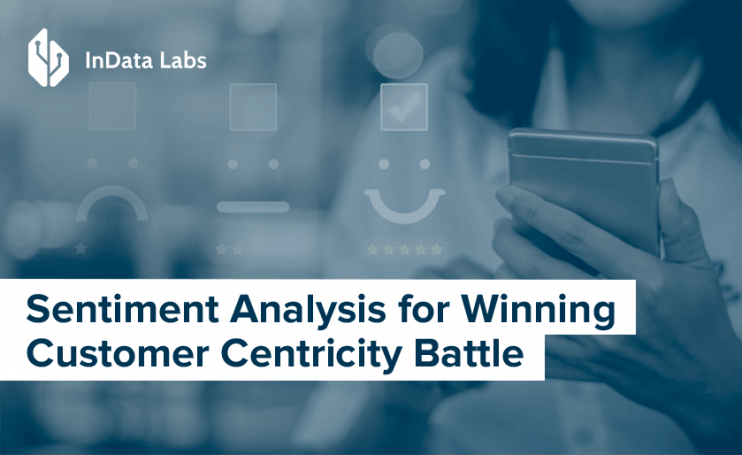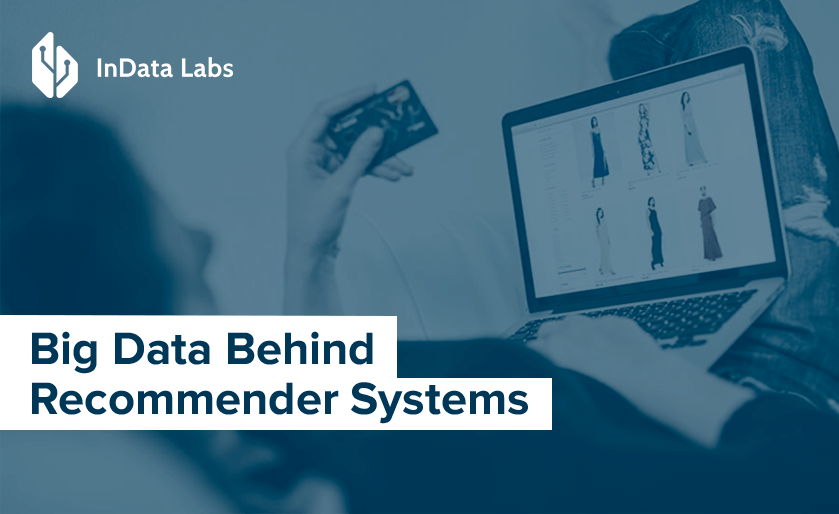According to Gartner Survey, Customer Experience is the new battlefield. 89% of companies are expected to compete mostly on the basis of customer experience, versus 36% four years ago.
In the era of customer-centricity, it is important for businesses to integrate the most efficient tools and technologies for customer service.
One of the most effective modern solutions that can help start creating outstanding customer service is consumer sentiment analysis.
Sentiment analysis provides companies with a much-needed assist to stay responsive to customers, market opportunities, and trends. Share on XCompanies have long depended on data from customer surveys, call center interactions and focus groups. Such data was structured, kept in one place and handled through BI applications help in improving customer service, product enhancement, and competitors benchmarking.
The situation has radically changed with the emergence of social media and various online platforms, where the majority of customers, both satisfied and furious, are dwelling. And this is their opinion that counts and shapes brands’ perception and sentiment.
What Is Sentiment Analysis?
Sentiment analysis is an approach that allows machine learning engineers to extract subjective information from unstructured text through contextual mining. This concept rests on natural language processing (NLP) and helps detect user emotions, opinions, and intents.
The prime use of sentiment analysis is opinion monitoring. It helps gauge user feedback, reactions to brands and products, or monitor social media threads while, for instance, launching a marketing campaign. Analyzed text samples can have such tags as positive, negative, or neutral.
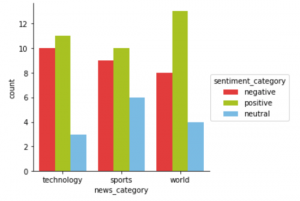
Source: medium.com
But sentiment analysis is not only about that classification of opinions into three groups. To date, it allows going beyond basic options and measure the scale of emotions or detect a wide range of human sentiments.
Another application of sentiment analysis is in detecting specific emotions, like happiness, anger, disappointment, anxiety, and so forth. As an example, all user tweets expressing emotions about the Grand Canyon can be gathered and visualized in the following manner:
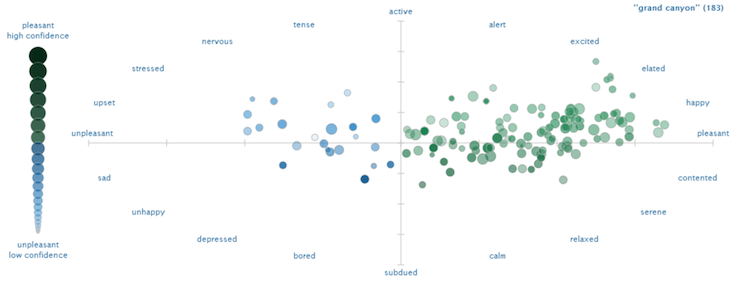
Source: csc2.ncsu.edu
Consumer intent analysis is the next level in interpreting text data. A user’s message or query can contain a hidden intent: request, intention to purchase, issues with products, and much more. Based on consumer reactions to the quality of services or goods, a provider can introduce necessary changes to make clients happy.
Additionally, sentiment analysis tools can help asses the polarity between very positive and very negative sentiments. Opinions can be rated on a scale, say, from 0 to 5, and the average will indicate the level of customer satisfaction.
Machine Learning in Customer Sentiment Analysis
Comprehensive analytics require tremendous amounts of data to train computers on to tackle tasks that humans do naturally. They need large pools of labeled text data for training. Each word in a phrase under analysis should be represented as a point into a hyperspace. The distance between two chosen points shows the degree of similarity or difference between the contextual meaning and a sentiment that is being explored.
In the end, machines, if properly taught, can read and understand sentiments more efficiently than humans.
An approach akin to this is the core of image recognition. You can learn more about deep learning in image recognition from InData Labs Blog.
Machine learning-based algorithms can process large datasets, which would be impossible otherwise. Such algorithms better recognize patterns in unstructured text and take into account more context for classifying samples. Therefore, AI-led solutions for sentiment analysis provide better insights.
How InData Labs Sentiment Analysis Technology Works
Simply put, sentiment analysis is the process of determining what emotions users express in a piece of writing or verbal remark. This approach can help leverage consumer emotions to improve decision-making and an entire business strategy.
As business niches have become highly competitive, winning attention of consumes has become a more complicated task as well. It is increasingly important to know what your target audience, competitors, and employees think about your products, services, and brand. And sentiment analytics is a relatively inexpensive way to gain this knowledge.
Say you want to find out how new movie is perceived on Twitter. Sentiment analysis technology will do that for you. You can learn why people find it good or bad. For example, if “too boring” is a prevailing trend, you immediately learn why the audience didn’t like the movie.
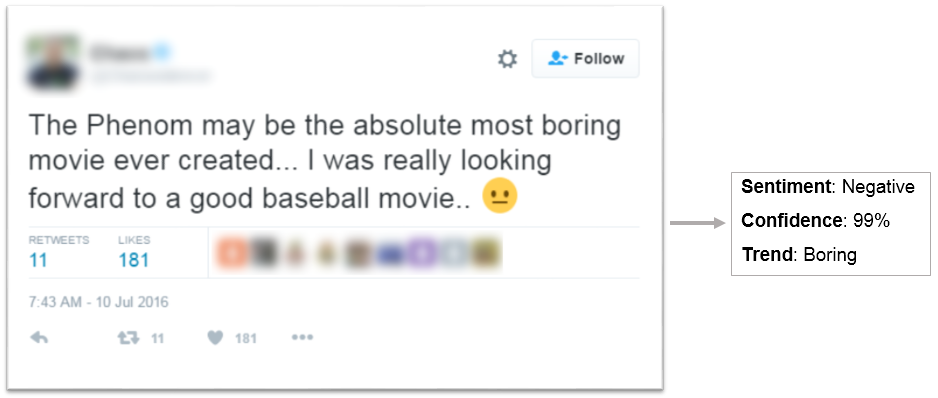
At InData Labs, we use machine learning to train our custom AI solutions, based on various rated reviews (movies, restaurants, hotels, etc.) and short social media posts, including emojis. We use only short posts while training our models. This helps us avoid ambiguity. Using real posts and reviews basically means that every item in the training dataset is annotated by humans first.
How Companies Like Yours Can Benefit from Sentiment Analysis:
Businesses have become customer-centered more than ever. Personalization, top-notch customer service, and 24/7 customer support are the reigning trends across industries.
Organizations of different size have already grown more comfortable with the idea of using customer sentiments and analytics as a tool to reshape strategy. So, it may be a high time for your business to augment traditional sentiment analysis with machine learning.
Sentiment analysis can give an immense boost to your business by assisting with the following:
- Analyze large amounts of publications on the web very fast
- Get a view of a wider public opinion
- Track and adjust marketing campaigns in real-time mode
- Eliminate bias possibilities associated with the use of focus groups and questionnaires
- Address your client’s concerns faster and in a proactive manner
- Save time on reading through thousands of reviews trying to define their sentiment
Automated analysis of customer feedback with sentiment analytics tools is now easier than ever before.
From InData Labs’ track records, machine learning-based custom solutions can come in handy to analyze data from social media and various forums posting feedback about new games. By using NLP models, data scientists can help you get valuable information on consumer sentiments about games interface, pricing, engine, bugs, and more. After that, the retrieved data will be shaped into the form of easy-to-read reports and stored for further uses.
Analysis of tweets and forums is a small part of what sentiment analysis can do for you. Likewise, it can be used to measure stress levels in call centers by using audio sentiment analytics. Call center agents can gauge how distressed a customer is and prevent the escalation of issues.
Sentiment analysis has become a part of the publishing and advertising field. AI-based tools allow analyzing which topic or headline catches more attention and attracts more followers. Systems used for that task analyze massive amounts of comments and shares to make suggestions about what type of content will be more engaging.
Like many AI-enabled solutions, sentiment analytics is not 100% accurate and reliable. Human-made verification is still an essential part of the process. Computers need a teacher to reaffirm that they adequately understand all the nuances of human speech.
Conclusion
Today’s companies have to survive in a very harsh reality, where bad experiences can be shared with millions of people around the world within a matter of seconds. For a company to improve customer experience, it is necessary to gather a lot of positive customer sentiment. But it is almost impossible to improve it without a proper way to track and measure sentiments in consumer messages. And it is difficult to get to the big picture fast while surrounded by terabytes of reviews, mentions, tweets, and blog posts.
We Make It Easy to Build Awesome Text Analysis Software
Already have a project in mind? Let’s talk.
